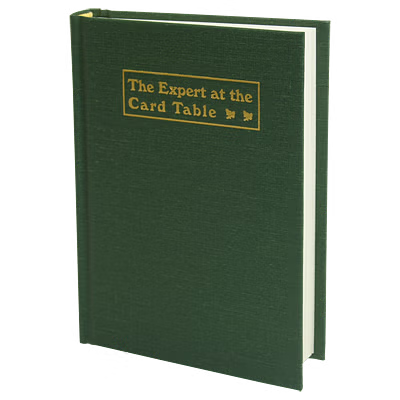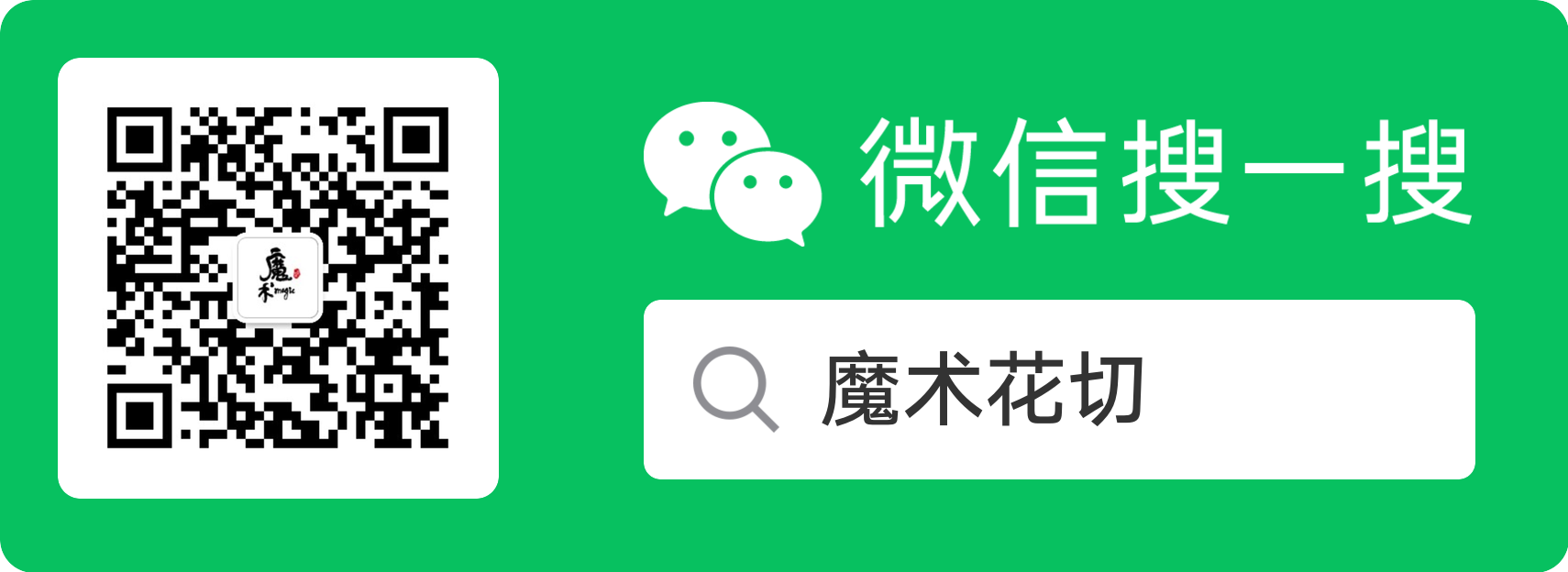移牌
单手移牌 [1]
这种移牌技巧在魔术界被称为“Charlies Pass”[2],据信是由同名的著名魔术师Charlier发明的。
左手持牌,牌面朝下,拇指尖位于一侧,中指和无名指的第一指节位于另一侧,小指的第一指节位于末端,食指伸展到底部。进行移牌时,先用拇指松开牌堆的下半部分,让其落入掌心(见图 65),然后用食指尖推起已落下的部分牌叠,直到它触及仍然支撑上半部分的拇指。此时,稍微张开中指和无名指,使拇指侧的上半部分越过已翻起的下半部分(见图 66),然后伸直食指,让上半部分牌叠掉入掌心,下半部分则覆盖在其上方。
在移牌过程中,小指放在底端中间位置非常有帮助,可以更好地控制两部分牌叠,并使表演者能够更垂直地握住牌。移牌时双手通常伴随着轻微的摆动或上下移动。它可以非常快速地完成,也是大多数纸牌玩家最喜欢的单手移牌技巧。 这一手法通常用于把观众选中的牌移到牌顶。当表演者展开牌让观众放回选中的牌时,他会用拇指尖抬起上半部分,选中的牌自然会放入空隙中。此时,移牌已经完成了一半,情况与第一次将下半部分牌叠落入掌心时相同。表演者通过向上或向下移动,或将手向观众倾斜,用食指抬起下半部分牌叠,完成移牌,将观众选中的牌移到牌顶。
纵向移牌
这个移牌技巧英文名(The Longitudinal Shift)很长,但是如果读者用心去练习这个手法,会发现实际操作起来非常简单且容易练习。
左手持牌,牌面朝下,拇指第一指节位于一侧中间,中指第一指节和无名指第二指节位于对面一侧,牌堆的下角夹在无名指和小指之间,抵在小指根,食指蜷曲在牌底。右手从上方伸过来,中指、无名指和小指位于外侧,拇指位于内侧。用右拇指在内侧分开牌叠约半英寸(约1.2厘米),并用小指第三指节插入两部分牌之间的角落(见图 67)。此时,牌叠已准备好进行移牌,但右手可以在不暴露牌叠内角间隙的情况下松开,左手小指仍保持在两叠牌之间。左拇指和手指将两部分牌牢牢握持在一起,牌叠看起来非常自然。
To make the shift, bring the right thumb against the side of the first finger, straighten out the first finger, press the end of the lower packet in against the left little finger and down against the curled up first finger, with the four right hand fingers; and with the left little finger and thumb draw off the upper packet towards the person (See Fig. 68), and as the lower packet springs into the right palm bring the upper packet back underneath.
The right thumb takes no part in the shift, and a favorable feature of the operation is that it may be performed without the right hand appearing to be used at all. The right fingers may be held almost straight, and the palm well away from the deck, the hand being slightly closed as the lower packet springs up. It can be made with practically no noise, and the action is well covered.
If desired this shift can be made with almost the whole deck exposed, by employing right second and third fingers only at end, and keeping first finger curled up on top. In this case the right thumb tip catches the end of the lower packet as it springs up.
要进行移牌时,将右拇指抵住食指侧面,伸直食指,用右手指压下部分牌堆的末端,使其靠在左小指和卷曲的食指上,同时用左小指和拇指将上部分牌拉向观众(见图 68),随着下部分牌弹入右掌,将上部分牌放回下方。
右拇指不参与移牌,一个有利的特点是可以在右手几乎不使用的情况下完成。右手指可以几乎伸直,手掌远离牌堆,手稍微闭合以使下部分牌弹起。整个过程几乎没有声音,动作也非常隐蔽。
如果需要,这个移牌技巧可以在几乎整个牌堆暴露的情况下完成,只需用右食指和中指在末端操作,保持食指卷曲在顶部。此时,右拇指尖可以抓住下部分牌的末端,使其弹起。
开放式移牌
This is another outcome of our constant but ever failing efforts to devise a perfect shift, and incidentally one that is not readily anticipated by the manner of holding the deck. The particular feature of this method is the open position in which the cards are held, the entire deck being exposed to view.
Hold the deck in the left hand, the first joint of the thumb at one side, first joints of second, third, and little fingers at opposite side, the little finger holding a break between the two packets near the corner, and the little and third fingers being separated about one inch. The first finger is curled up against the bottom. Bring the right hand over, and seize the ends of deck close to right side corners, with the second finger and thumb tips, the thumb seizing only the lower packet below the break, the first finger curled up on top. (See Fig. 69.) The left third and little fingers take no part in the action and are held idly out of the way.
To make the shift, curl the right first finger back over the side of the deck, between the left little and third fingers, until the root of the finger nail rests against the edge of the top card. Now press the upper packet against the left thumb and downwards by straightening out the right first finger, at the same time drawing the lower packet to the right and upwards with the right thumb and second finger (See Fig. 70), and as the sides clear each other tilt the left side of the lower or right hand packet up on top. The upper packet should not fall into the left hand. It must be caught by the curled up first finger and first joints of the other left fingers, as it clears the side of the under packet. The left thumb never leaves its position against the side of the upper packet, and the tip should be held sufficiently above it to receive the lower packet as it is brought on top. The left little finger is not inserted between the two packets, but merely holds the break.
The shift can be made like a flash, and with the cards in perfect order. When executed perfectly, the only sound is the slipping of one packet over the other. There is no snap or crack, and it is in every way worthy of the practice necessary to acquire it. With the face of the deck turned upward it produces a "transformation" that ranks with the best of them.
The same shift may be made with the deck held flat in the palm, the left thumb lying idly across the top, and the first finger at the side with the others, but we much prefer the former position though it is a great deal more difficult. The latter position is an excellent one when it is necessary to make a shift that is apparently a simple cut, in which event the right hand does not tilt its packet on top. The hands immediately separate and the under packet is placed on top when desired.
S. W. E. 移牌
WE HAVE not dubbed the following process with our initials because we wish to appear "big on the bills," but merely to give it a name. Still, we must confess to some satisfaction in having originated what we believe to be the most rapid, and, for certain purposes, the most perfect shift ever devised. The method is practically the same as the "Longitudinal," but as the deck is held crosswise it is much more rapid. The position is open and natural, and the shift possesses many advantages for conjuring purposes. opposite or lower end, little finger holding a break between the two packets at end, by the corner of the lower packet being between the little and third fingers, the little finger lying partially across the corner of the under packet. (See Fig. 71.)
Hold the deck in the left hand, face down, first joint of the thumb against middle of one end, second, third and little fingers against the This position, like that of the "Longitudinal," allows the tips of the second, third and little fingers to appear over the top of the deck, and the fact that there is a break is not apparent to a spectator. The first finger is curled up against the bottom. The break is held only at the lower end, and at the inside, the other fingers and thumb holding the packet firmly together.
Now bring the right hand over the lower or right-hand end of the deck, and seize the sides close as possible to the lower corners, between the second and third fingertips and thumb, the first finger curled up on top out of the way. This leaves at least two-thirds of the deck in view. (See Fig. 72.)
To make the shift raise the right thumb to the edge of the side, draw the top packet in and down with the left thumb and little finger, and press the lower packet out and down, between the right second and third finger tips and the left first finger which is curled up underneath; the left second finger at the end helps to control the lower packet as it is pressed out. This action will tilt the opposite sides of both packets upwards, and as they clear each other the right thumb tip catches the under packet, and the left third finger catches the upper packet and it is brought back underneath. (See Fig. 73.)
When the shift is mastered the entire action is accomplished by a pressure in opposite directions on the lower packet, and the packets reverse like a flash, but of course it must be practiced slowly until the knack is obtained. The positions of the hands may be taken with easy deliberation, as there is no indication that a shift is meditated. It may be made with the hands stationary without exposing the action. With the deck face up it makes an instantaneous "Transformation," and the position of the deck permits the operator to get a glimpse of the index without being observed.
The shift may be made with the right hand almost entirely covering the deck, but this alters the whole character and aim of the process, the main endeavor is to make it as open and free from concealment as possible.
斜对角掌藏移牌
THE plan of having one or several selected cards inserted in the deck, then forcing them through slightly diagonally, and twisting them out to the top or bottom, is well known to most conjurers, and by some is treated as a blind shuffle. That the process is not satisfactory is seen by the fact that it is seldom or never employed, and but rarely even mentioned in any list of card slights. Our efforts to improve, or rather to combine the first part of this manoeuvre with a process for palming the inserted cards, instead of placing them on top or bottom of the deck, is shown in the following description. The action is silent, rapid, undetectable if well performed, and takes place under the ordinary movement of passing the deck to be shuffled.
Hold the deck in the left hand, by sides, between the first joints of thumb, and second, third and little fingers, first finger curled up at bottom. Allow spectator to insert selected card in outer end of deck, pushing it in until about half an inch only protrudes. Now bring the right hand over deck with the little finger at side corner of protruding card, second and third fingers at middle of end, and first finger close to end corner, and the thumb close to the inner end corner of the deck. Apparently push the card straight home, but really push the protruding end with the right little finger, about quarter of an inch to the left, so that the right first finger can push the tilted corner down the side of the deck, the card moving slightly diagonally, and the opposite corner just grazing the right thumb, and protruding about three-quarters of an inch. The left third and little fingers are released sufficiently to allow the card to protrude at the side. The left thumb now takes the place of the right first finger, pushing the corner flush with side of deck. ( See Fig. 74.)
The diagonal position of the selected card is now perfectly concealed, and the deck is held in a natural and regular manner. A little practice at the diagonal slide enables one to get the card in that position instantaneously. The next action is to palm the selected card in the left hand, as the right passes the deck to be shuffled.
With the left little finger against the side of card, swing or turn it inwards, using the right thumb as a pivot, straighten out left first, second, and third fingers, catching the outer end as it turns, and at the same time sliding pack outwards and to the right, the left hand turning over and inwards with the palmed card (see Fig. 75) and the little finger slipped to the end.
There should be no force or twist employed, the card running out as freely as though drawn. The card and the deck must continue on the same plane until quite free of each other. The left little finger may press the side of the card very slightly upwards, so that as it is palmed it will bend into instead of away from the left hand. As the card is being turned by the little finger the left thumb is raised, letting the right thumb with the corner of deck pass under it, so that the card can lie parallel with, but still above, the left palm. As the deck is slid out, the right thumb slides along the side of the card, and it is not actually palmed until the hands are almost free of each other.
The whole action may be made quick as a flash and without a sound, yet when performed quite slowly is still a perfect blind. The left hand may seize the deck by the corner, between the first finger and thumb, as the card is palmed, leaving the right hand free (see Fig. 76); but the beauty of the shift is in the natural and simple manner of palming the selected card, by the ordinary movement the right hand makes in passing the deck to be shuffled.
We wish to particularly impress our readers with the merits of this palm-shift. It is not difficult if a proper understanding of the action is obtained, and it is of very great assistance in card tricks. It dispenses to a great extent with the regular shifts and blind shuffles, and it can be accomplished under the very nose of a shrewd spectator without an inkling of what is taking place. The usual procedure of card handlers is to insert the little finger over the selected card, shift the two packets and palm the card from the top in the right hand. This process takes more time, the shift must be concealed by a partial turn, swing or drop of the hands; and to palm, the deck must be covered at least for an instant. In the palm-shift described the card is placed in its diagonal position with apparently the customary movement of squaring up, and the rest is accomplished, as it were, by handing the deck to be shuffled.
Several cards may be palmed together, when inserted at different points, or from one point, or from top, or bottom. If the top card is to be shifted, it is slipped into the same diagonal position and held in place by the right little finger being curled up on top. The action is the same. When the single card palm-shift is acquired, the rest will come easily.


